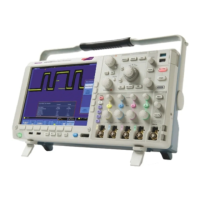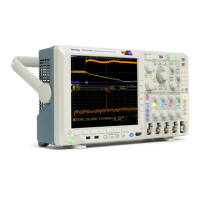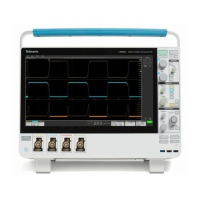Performance Verification
13. Calculate the R
MS noise (RMS noise = SMV – AMV), and enter the
calculated RMS noise into the appropriate segment of the Test Record.
14. Set the Acquis
ition Mode to Sample:
a. Push the front-panel Horizontal Acquire button.
b. If necessary, push the bottom-bezel Mode button to display the
Acquisition Mode menu.
c. Push the side-bezel Sample button.
15. Set the input impedance to 50 Ω:
a. Push the front-panel button for the channel being tested (1, 2, 3, or 4)
1
.
b. Push the bottom-bezel Impedance button to select 50 Ω.
16. Push the
front-panel Wave Inspector Measure button, and repeat steps 5
through 14.
17. Set the
channel under test to 1 MΩ impedance, and set the bandwidth to
250 MHz:
a. Push t
he front-panel button for the channel being tested (1, 2, 3, or 4)
1
.
b. Push the bottom-bezel Impedance button to select 1MΩ.
c. Push the bottom-bezel Bandwidth button, and then push the side-bezel
250MHz button.
18. Push the front-panel Waveform Inspector Measure button, and then repeat
steps 5 through 16.
19. Set the channel under test to 1 MΩ impedance, and set the bandwidth to
20 MHz:
a. Push the front-panel button for the channel being tested (1, 2, 3, or 4)
1
.
b. Push the bottom-bezel Impedance button to select 1MΩ.
c. Push the bottom-bezel Bandwidth button, and then push the side-bezel
20MHz button.
20. Push the front-panel Wave Inspector Measure button, and then repeat steps 5
through 16.
21. Select the next channel (2, 3, or 4)
1
to test, and then push the front-panel
Wave Inspector Measure button.
22. Repeat steps 5 through 2 1 until all channels have been tested.
1
Channels 3 and 4 are only on four-channel oscilloscopes.
MSO4000 and DPO4000 Series Specifications and Performance Verification 47

